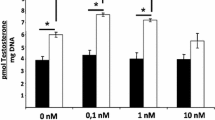Abstract
D-aspartic acid (D-Asp), aromatase enzyme activity and the putative D-Asp involvement on aromatase induction have been studied in the testis of mature boars. The peroxidase-antiperoxidase and the indirect immunofluorescence methods, applied to cryostat and paraffin sections, were used to evaluate D-Asp and aromatase distributions. D-Asp level was dosed by an enzymatic method performed on boar testis extracts. Biochemical aromatase activity was determined by in vitro experiments carried out on testis extracts. D-Asp immunoreactivity was found in Leydig cells, and, to a lesser extent, in germ cells. Analogously, aromatase immunoreactivity was present in Leydig cells, but absent from seminiferous tubule elements. In vitro experiments showed that the addition of D-Asp to testicular tissue acetone powder induced a significant increase of aromatase activity, as assessed by testosterone conversion to 17β-estradiol. Enzyme Km was not affected by D-Asp (about 25 nM in control and D-Asp added tests). These findings suggest that D-Asp could be involved in the local regulation of aromatase in boar Leydig cells and intervenes in this organ’s production of estrogens.
Similar content being viewed by others
References
D’Aniello A, Di Fiore MM, Fisher G. Occurrence of D-as-partic acid in animal tissues and its role in the nervous and endocrine systems. Trends in Comparative Biochemistry and Physiology 1998, 4: 1–21.
Lee J-A, Homma H, Sakai K, et al. Immunohistochemical localization of D-aspartate in the rat pineal gland. Biochem Biophys Res Commun 1997, 231: 505–8.
Schell MJ, Cooper OB, Snyder SH. D-aspartate localizations imply neuronal and neuroendocrine roles. Proc Natl Acad Sci USA 1997, 94: 2013–8.
Lee JA, Homma H, Tashiro K, Iwatsubo T, Imai K. D-aspar-tate localization in the rat pituitary gland and retina. Brain Res 1999, 838: 193–9.
D’Aniello A, Di Cosmo A, Di Cristo C, Annunziato L, Petrucelli L, Fisher G. Involvement of D-aspartic acid in the synthesis of testosterone in rat testes. Life Sci 1996, 59: 97–104.
Sakai K, Homma H, Lee J-A, et al. Localization of D-aspartic acid in elongate spermatids in rat testis. Arch Biochem Biophys 1998, 351: 96–105.
D’Aniello A, Di Fiore MM, D’Aniello G, Colin FE, Lewis G, Setchell BP. Secretion of D-Aspartic acid by the rat testis and its role in endocrinology of the testis and spermatogenesis. FEBS Letters 1998, 436: 23–7.
D’Aniello A, Di Fiore MM, Fisher GH, et al. Occurrence of D-Aspartic acid and N-Methyl-D-Aspartic acid in rat neuroendocrine tissues and their role in the modulation of Luteinizing hormone and Growth hormone release. FASEB J 2000, 14: 699–714.
Bardin CW, Hardy MP, Catteral J F, Androgens. In: Adashi EY, Rock JA, Rosenwaks Z eds. Reproductive Endocrinology, Surgery and Technology. Philadelphia: Lippincott-Raven. 1996, 506–25.
Bilinska B, Schmalz-Fraczek B, Kotula M, Carreau S. Pho-toperiod-dependent capability of androgen aromatization and the role of estrogens in the bank vole testis visualized by means of immunohistochemistry. Mol Cell Endocrinol 2001, 178: 189–98.
Carreau S, Genissel C, Bilinska B, Levallet J. The oestrogen sources in the testis and the reproductive tract of the male. Int J Androl 1999, 22: 211–23.
Carreau S, Bilinska B, Levallet J. Male germ cells. A new source of estrogens in the mammalian testis. Ann Endocrinol (Paris) 1998, 59: 79–92.
Assisi L, Botte V, D’ Aniello A, Di Fiore MM. Enhancement of aromatase activity by D-aspartic acid in the ovary of lizard Podarcis s. sicula. Reproduction 2001, 121: 803–8.
Raeside JI, Wilkinson CR, Farkas G. Ontogenesis of oestrogen secretion by porcine fetal testes. Acta Endocrinol (Copenh) 1993, 128: 549–54.
Conley AJ, Corbin CJ, Hinshelwood MM, et al. Functional aromatase expression in porcine adrenal gland and testis. Biol Reprod 1996, 54: 497–505.
Lowry OH, Rosebrough NJ, Farr AL, Randall RJ. Protein measurement with Folin phenol reagent. J Biol Chem 1951, 193: 265–75.
Saez JM. Leydig cells: endocrine, paracrine and autocrine regulation. Endocr Rev 1994, 15: 574–626.
Hess RA. Oestrogen in fluid transport in efferent ducts of the male reproductive tract. Rev Reprod 2000, 5: 84–92.
Carreau S, Bourguiba S, Lambard S, et al. Aromatase expression in male germ cells. J Steroid Biochem Mol Biol 2001, 79: 203–8.
Pentikainen V, Erkkila K, Suomalainen L, Parvinen M, Dunkel L. Estradiol acts as a germ cell survival factor in the human testis in vitro. J Clin Endocrinol Metab 2000, 85: 2057–67.
Genissel C, Levallet J, Carreau S. Regulation of cytochrome P450 aromatase gene expression in the adult rat Leydig cells: comparison with estradiol production. J Endocrinol 2001, 168: 95–105.
Inkster S, Yue W, Brodie A. Human testicular aromatase: immunocytochemical and biochemical studies. J Clin Endocrinol Metab 1995, 80: 1941–7.
Bilinska B, Lesniak M, Schmalz B. Are ovine Leydig cells able to aromatize androgens? Reprod Fertil Dev 1997, 9: 193–194
Levallet J, Bilinska b, Mittre H, Genissel C, Fresnel J, Carreau S. Expression and immunolocalization of functional cytochrome P450 aromatase in mature rat testicular cells. Biol Reprod 1998, 58: 919–26.
Almadhidi J, Seralini GE, Fresnel J, Silberzahn P, Gaillard JL. Immunohistochemical localization of cytochrome P450 aromatase in equine gonads. J Histochem Cytochem 1995, 45: 571–7.
Author information
Authors and Affiliations
Corresponding author
Rights and permissions
About this article
Cite this article
Lamanna, C., Assisi, L., Botte, V. et al. Endogenous testicular D-aspartic acid regulates gonadal aromatase activity in boar. J Endocrinol Invest 29, 141–146 (2006). https://doi.org/10.1007/BF03344087
Accepted:
Published:
Issue Date:
DOI: https://doi.org/10.1007/BF03344087




